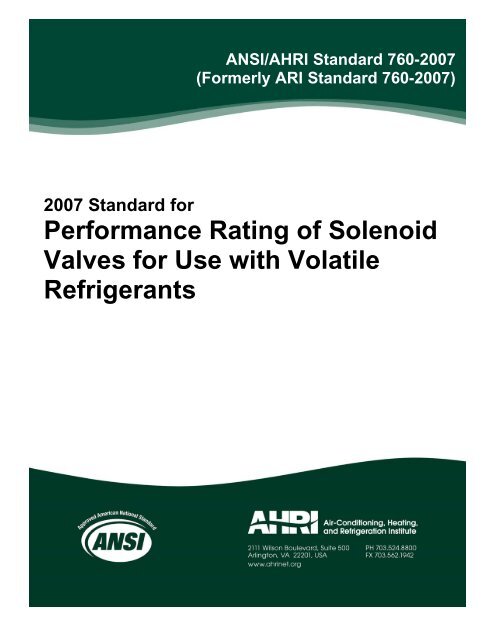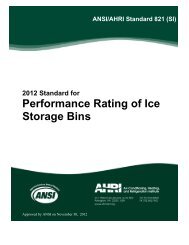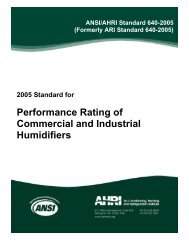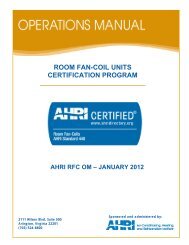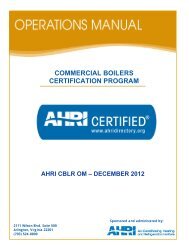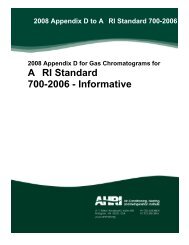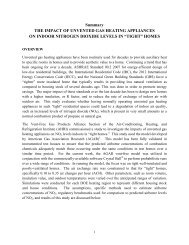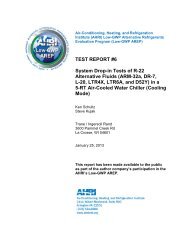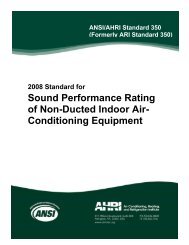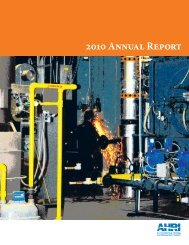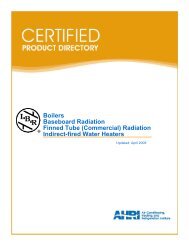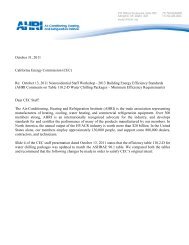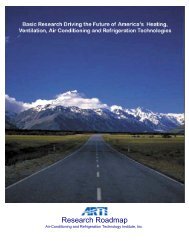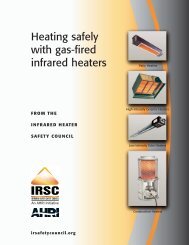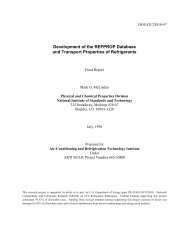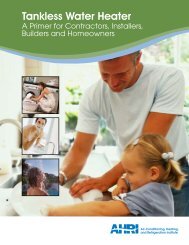ANSI/AHRI Standard 760-2007
ANSI/AHRI Standard 760-2007
ANSI/AHRI Standard 760-2007
Create successful ePaper yourself
Turn your PDF publications into a flip-book with our unique Google optimized e-Paper software.
<strong>ANSI</strong>/<strong>AHRI</strong> <strong>Standard</strong> <strong>760</strong>-<strong>2007</strong><br />
(Formerly ARI <strong>Standard</strong> <strong>760</strong>-<strong>2007</strong>)<br />
<strong>2007</strong> <strong>Standard</strong> for<br />
Performance Rating of Solenoid<br />
Valves for Use with Volatile<br />
Refrigerants
IMPORTANT<br />
SAFETY DISCLAIMER<br />
<strong>AHRI</strong> does not set safety standards and does not certify or guarantee the safety of any products, components or systems<br />
designed, tested, rated, installed or operated in accordance with this standard/guideline. It is strongly recommended<br />
that products be designed, constructed, assembled, installed and operated in accordance with nationally recognized<br />
safety standards and code requirements appropriate for products covered by this standard/guideline.<br />
<strong>AHRI</strong> uses its best efforts to develop standards/guidelines employing state-of-the-art and accepted industry practices.<br />
<strong>AHRI</strong> does not certify or guarantee that any tests conducted under its standards/guidelines will be non-hazardous or<br />
free from risk.<br />
Note:<br />
This standard supersedes ARI <strong>Standard</strong> <strong>760</strong>-2001.<br />
Price $15.00 (M) $30.00 (NM)<br />
Printed in U.S.A.<br />
©Copyright <strong>2007</strong>, by Air-Conditioning, Heating and Refrigeration<br />
Institute<br />
Registered United States Patent and Trademark Office
TABLE OF CONTENTS<br />
SECTION<br />
PAGE<br />
Section 1. Purpose ..............................................................................................................................1<br />
Section 2. Scope .................................................................................................................................1<br />
Section 3. Definitions .........................................................................................................................1<br />
Section 4.<br />
Test Requirements.............................................................................................................2<br />
Section 5. Rating Requirements .........................................................................................................2<br />
Section 6.<br />
Section 7.<br />
Section 8.<br />
Minimum Data Requirements for Published Ratings........................................................4<br />
Marking and Nameplate Data............................................................................................4<br />
Conformance Conditions...................................................................................................4<br />
TABLES<br />
Table 1.<br />
<strong>Standard</strong> Rating Conditions...............................................................................................3<br />
APPENDICES<br />
Appendix A.<br />
References - Normative.....................................................................................................5<br />
Appendix B. References - Informative ...................................................................................................5<br />
Appendix C.<br />
Method of Testing for Rating Solenoid Valves for Maximum Operating<br />
Pressure Differential (MOPD) - Normative ......................................................................6<br />
TABLES FOR APPENDICES<br />
Table C1. Pressure-tap Hole Diameters and Lengths ........................................................................8<br />
FIGURES FOR APPENDICES<br />
Figure C1. Typical System Piping for Solenoid Valve MOPD Test with Gas or Liquid ...................7<br />
Figure C2. Typical Electrical Test Apparatus for an Alternating Current Solenoid Valve ................9<br />
Figure C3.<br />
Typical Electrical Test Apparatus for a Direct Current Solenoid Valve.........................10
<strong>ANSI</strong>/<strong>AHRI</strong> STANDARD <strong>760</strong>-<strong>2007</strong><br />
PERFORMANCE RATING OF<br />
SOLENOID VALVES FOR USE WITH VOLATILE<br />
REFRIGERANTS<br />
Section 1. Purpose<br />
1.1 Purpose. The purpose of this standard is to establish for Solenoid Valves: definitions; test requirements; rating<br />
requirements; minimum data requirements for Published Ratings; marking and nameplate data; and conformance conditions.<br />
1.1.1 Intent. This standard is intended for the guidance of the industry, including manufacturers, engineers, installers,<br />
contractors and users.<br />
1.1.2 Review and Amendment. This standard is subject to review and amendment as technology advances.<br />
Section 2. Scope<br />
2.1 Scope. This standard applies to Solenoid Valves for use with Volatile Refrigerants as defined in Section 3.<br />
Section 3. Definitions<br />
All terms in this document follow the standard industry definitions in the current edition of ASHRAE Terminology of Heating,<br />
Ventilation, Air Conditioning and Refrigeration unless otherwise defined in this section.<br />
3.1 Bubble Point. Refrigerant liquid saturation temperature at a specified pressure.<br />
3.2 Dew Point. Refrigerant vapor saturation temperature at a specified pressure.<br />
3.3 Main. Tubing or piping by which the Solenoid Valve is connected to the apparatus.<br />
3.4 Maximum Operating Pressure Differential (MOPD). The maximum pressure difference between the solenoid valve inlet<br />
and the solenoid valve outlet at which the Solenoid Valve will operate, psi [kPa].<br />
3.5 Pressure Drop. The pressure difference between the solenoid valve inlet and the solenoid valve outlet with the main port<br />
(orifice) open, psi [kPa].<br />
3.6 Published Rating. A statement of the assigned values of those performance characteristics, under stated Rating Conditions,<br />
by which a unit may be chosen to fit its application. These values apply to all units of like nominal size and type (identification)<br />
produced by the same manufacturer. The term Published Rating includes the rating of all performance characteristics shown on<br />
the unit or published in specifications, advertising or other literature controlled by the manufacturer, at stated Rating Conditions.<br />
3.6.1 Application Rating. A rating based on tests performed at application Rating Conditions (other than <strong>Standard</strong><br />
Rating Conditions).<br />
3.6.2 <strong>Standard</strong> Rating. A rating based on tests performed at <strong>Standard</strong> Rating Conditions.<br />
3.7 Rating Conditions. Any set of operating conditions under which a single level of performance results and which causes<br />
only that level of performance to occur.<br />
3.7.1 <strong>Standard</strong> Rating Conditions. Rating Conditions used as the basis of comparison for performance characteristics.<br />
3.8 "Shall" or "Should." "Shall" or "should" shall be interpreted as follows:<br />
1
<strong>ANSI</strong>/<strong>AHRI</strong> STANDARD <strong>760</strong>-<strong>2007</strong><br />
3.8.1 Shall. Where "shall" or "shall not" is used for a provision specified, that provision is mandatory if compliance<br />
with the standard is claimed.<br />
3.8.2 Should. "Should" is used to indicate provisions which are not mandatory but which are desirable as good practice.<br />
3.9 Solenoid Valve. A valve which is actuated by the magnetic action of an electrically energized coil. The opposite action is<br />
accomplished by gravity, pressure or spring action.<br />
3.9.1 Direct-Action Solenoid Valve. A valve in which the magnetic power of an electrically energized coil moves the<br />
main port (orifice) closure member.<br />
3.9.2 Normally Closed Solenoid Valve. A valve which is closed when de-energized. When the coil is electrically<br />
energized, the closure member is moved away from and off the port (orifice) to cause the opening action.<br />
3.9.3 Normally Open Solenoid Valve. A valve which is open when de-energized. When the coil is electrically<br />
energized, the closure member is moved toward and onto the port (orifice) to cause the closing action.<br />
3.9.4 Pilot-Operated Solenoid Valve. A valve in which the motion of a direct-acting member allows a pressure<br />
difference to occur across the main port (orifice) closure member, causing it to move.<br />
3.10 Solenoid Valve Capacity. The mass flow rate of a fluid through the Solenoid Valve, equated to tons of refrigeration [kW] at<br />
the specified conditions.<br />
Section 4. Test Requirements<br />
4.1 Capacity Tests. All capacity tests shall be in accordance with the test procedure outlined in <strong>ANSI</strong>/ASHRAE <strong>Standard</strong><br />
158.1.<br />
4.2 MOPD Tests. All MOPD tests shall be in accordance with the test procedure in Appendix C.<br />
4.2.1 If the Solenoid Valve MOPD depends on the valve position, the valve shall be tested in all positions for which the<br />
ratings apply.<br />
Section 5. Rating Requirements<br />
5.1 Rating Requirements. Published capacity ratings shall consist of <strong>Standard</strong> Ratings and may include Application Ratings.<br />
The <strong>AHRI</strong> <strong>Standard</strong> Ratings of Solenoid Valve Capacity for Volatile Refrigerants shall be stated in tons of refrigeration [kW] and<br />
at the conditions specified in Table 1<br />
5.2 <strong>Standard</strong> Rating Conditions. <strong>Standard</strong> ratings shall be for liquid service applications of solenoid valves per Table 1.<br />
5.2.1 Liquid Service Solenoid Valve Entrance Conditions.<br />
a. Saturated Condensing (Dew Point) Temperature: 110°F [43.3°C]<br />
b. Liquid Service Temperature: 100°F [37.8 o C]<br />
c. Saturated Evaporating (Bubble Point) Temperature: 40 o F [4.4 o C]<br />
5.2.2 Pressure Drop Values.<br />
5.2.2.1 Liquid Service. The Pressure Drop across the Solenoid Valve shall be the closest integer value in psi<br />
o o<br />
[kPa] equivalent to a 1.0 F [0.6 C] drop in saturation temperature.<br />
5.2.3 In no case shall the Pressure Drop be less than required for proper operation of the Solenoid Valve.<br />
2<br />
Table 1. <strong>Standard</strong> Rating Conditions
<strong>2007</strong><br />
Liquid Service Solenoid Valve Entrance Condition<br />
Saturated Condenser (Dew Point) Temperature<br />
Liquid Service Temperature<br />
Pressure Drop Across Valve<br />
Enthalpy<br />
°F<br />
110<br />
100<br />
<strong>ANSI</strong>/<strong>AHRI</strong> STANDARD <strong>760</strong>-<br />
°C<br />
43.3<br />
37.8<br />
Closest integer psi equivalent to 1.0 °F [0.6°C] drop in saturated<br />
pressure<br />
Expansion point enthalpy based on 100 °F [37.8°C] liquid<br />
refrigerant entering the liquid service valve and vapor at a dew<br />
point pressure corresponding to 40°F [4.4°C] leaving the<br />
evaporator.<br />
5.2.4 The solenoid valve capacity ratings for refrigerant liquid service shall be based on the method described in C4.1.<br />
5.2.5 Expansion Point Enthalpy (h f ). Enthalpy based on 100 o F [37.8 o C] liquid refrigerant entering the liquid service<br />
Solenoid Valve.<br />
5.2.6 Enthalpy of the Refrigerant Suction Gas (h g ). Enthalpy based on vapor at a dew point pressure corresponding to<br />
40 o F [4.4 o C] leaving the evaporator.<br />
5.3 MOPD Ratings. MOPD ratings shall be obtained in accordance with 4.2 and Appendix C, and shall be stated in psi [kPa].<br />
5.3.1 If the solenoid valve MOPD depends on the valve orientation, then it shall be rated for the orientation that results<br />
in the lowest MOPD pressure.<br />
5.4 Application Ratings. Application Ratings give performance data at operating conditions other than those given above.<br />
Applications Ratings shall contain all information shown in 6.2. Published Ratings shall be subject to the tolerances of this<br />
standard.<br />
5.4.1 Liquid Service.<br />
5.4.1.1 In addition to <strong>AHRI</strong> standard capacity ratings at pressure drop values specified in Table 1, capacity<br />
ratings may also be given at other pressure drop values, provided that they are specified as such and based on all<br />
the other conditions given in 5.2.<br />
5.4.2 Suction Service.<br />
5.4.2.1 The Pressure Drop shall be 1.0 psi [6.9 kPa] for all refrigerants unless the manufacturer's stated lowest<br />
pressure differential is greater than 1.0 psi [6.9 kPa] for satisfactory operation.<br />
5.4.2.2 Solenoid Valves requiring greater than 1.0 psi [6.9 kPa] pressure differential shall show an <strong>AHRI</strong><br />
<strong>Standard</strong> Rating at the manufacturer's stated lowest pressure differential required for satisfactory operation.<br />
5.4.2.3 Enthalpy of the Refrigerant Suction Gas (h g ). Enthalpy based on vapor at a dew point pressure<br />
corresponding to 40 o F [4.4 o C] leaving the evaporator.<br />
5.4.3 Discharge Gas Service.<br />
5.4.3.1 The Pressure Drop shall be 2.0 psi [14 kPa] for all refrigerants.<br />
5.4.3.2 Discharge Gas Temperature. The temperature that would result from isentropic compression from the<br />
saturated evaporator (Dew Point) temperature with 25.0 o F [13.9 o C] superheat, to a saturated condensing (Bubble<br />
Point) temperature of 110 o F [43.3 o C] with 50.0 o F [27.8 o C] added as an approximation of the actual polytropic<br />
refrigerant compression process.<br />
5.4.3.3 In addition to the <strong>Standard</strong> Rating at a 2.0 psi [14 kPa] Pressure Drop, Application Ratings for discharge<br />
gas service may be published for the following pressure drop values:<br />
5.0 [34], 10.0 [68.9], 25.0 [172], 50.0 [344], 75.0 [517], 100 [689] psi [kPa], for all refrigerants.<br />
3
<strong>ANSI</strong>/<strong>AHRI</strong> STANDARD <strong>760</strong>-<strong>2007</strong><br />
5.5 Tolerances. To comply with this standard, measured test results shall not be less then 95% of published capacity rating.<br />
Section 6. Minimum Data Requirements for Published Ratings<br />
6.1 Minimum Data Requirements for Published Ratings. As a minimum, Published Ratings shall include all <strong>Standard</strong> Ratings.<br />
All claims to ratings within the scope of this standard shall include the statement “Rated in accordance with <strong>AHRI</strong> <strong>Standard</strong> <strong>760</strong>.”<br />
All claims to ratings outside the scope of this standard shall include the statement “Outside the scope of <strong>AHRI</strong> <strong>Standard</strong> <strong>760</strong>.”<br />
Wherever Applications Ratings are published or printed, they shall include a statement of the conditions at which the ratings<br />
apply.<br />
6.2 Published Ratings. Published Ratings shall include the following information:<br />
a. MOPD, psi [kPa] (See 5.3.1, when MOPD varies with valve orientation)<br />
b. Refrigerant designation(s) per <strong>ANSI</strong>/ASHRAE 34 with Addenda<br />
c. <strong>AHRI</strong> standard capacity rating(s)<br />
d. Model designation<br />
e. Line connections (size and type)<br />
f. Electrical characteristics: voltage(s), V; frequency(s), Hz (if alternating current); and power, W<br />
g. Manufacturer's name and address<br />
Section 7. Marking and Nameplate Data<br />
7.1 Marking and Nameplate Data. As a minimum, each Solenoid Valve shall be marked with the following information:<br />
a. The manufacturer's name or trade name<br />
b. Model designation<br />
c. Electrical characteristics: voltage(s), V; frequency(s), Hz (if alternating current); and power, W<br />
d. MOPD, psi [kPa] (See 5.3.1, when MOPD varies with valve orientation)<br />
7.1.1 For voltage ranges covered by <strong>AHRI</strong> <strong>Standard</strong> 110 or IEC <strong>Standard</strong> 60038, nameplate voltages for 60 Hertz<br />
systems shall include one or more of the equipment nameplate voltage ratings shown in Table 1 of <strong>AHRI</strong> <strong>Standard</strong> 110, and<br />
nameplate voltages for 50 Hertz systems shall include one or more of the utilization voltages shown in Table 1 of IEC<br />
<strong>Standard</strong> 60038.<br />
7.1.1.1 Voltage ratings not covered by <strong>AHRI</strong> <strong>Standard</strong> 110 or IEC <strong>Standard</strong> 60038, are permitted.<br />
Section 8. Conformance Conditions<br />
8.1 Conformance. While conformance with this standard is voluntary, conformance shall not be claimed or implied for<br />
products or equipment within the standard’s Purpose (Section 1) and Scope (Section 2) unless such claims meet all of the<br />
requirements of the standard and all of the testing and rating requirements are measured and reported in complete compliance with<br />
the standard. Any product that has not met all the requirements of the standard shall not reference, state, or acknowledge the<br />
standard in any written, oral, or electronic communication.<br />
4
<strong>2007</strong><br />
<strong>ANSI</strong>/<strong>AHRI</strong> STANDARD <strong>760</strong>-<br />
APPENDIX A. REFERENCES - NORMATIVE<br />
A1 Listed here are all standards, handbooks and other publications essential to the formation and implementation of the<br />
standards. All references in this appendix are considered as part of the standard.<br />
A1.1 <strong>ANSI</strong>/ASHRAE <strong>Standard</strong> 34-2004 with Addenda, Designation and Safety Classification of Refrigerants, 2004,<br />
American National <strong>Standard</strong>s Institute/American Society of Heating, Refrigerating and Air-Conditioning Engineers, Inc.,<br />
1791 Tullie Circle N.E., Atlanta, GA 30329, U.S.A.<br />
A1.2 <strong>ANSI</strong>/ASHRAE <strong>Standard</strong> 41.1-1986 (RA 2006), <strong>Standard</strong> Method for Temperature Measurement, 2006,<br />
American National <strong>Standard</strong>s Institute/American Society of Heating, Refrigerating and Air-Conditioning Engineers, Inc.,<br />
1791 Tullie Circle N.E., Atlanta, GA 30329, U.S.A.<br />
A1.3 <strong>ANSI</strong>/ASHRAE <strong>Standard</strong> 41.3-1989, <strong>Standard</strong> Method for Pressure Measurement, 1989, American National<br />
<strong>Standard</strong>s Institute/American Society of Heating, Refrigerating and Air-Conditioning Engineers, Inc., 1791 Tullie Circle<br />
N.E., Atlanta, GA 30329, U.S.A.<br />
A1.4 <strong>ANSI</strong>/ASHRAE <strong>Standard</strong> 158.1-2004, Method of Testing Capacity of Refrigerant Solenoid Valves, 2004,<br />
American National <strong>Standard</strong>s Institute/American Society of Heating, Refrigerating and Air-Conditioning Engineers, Inc.,<br />
1791 Tullie Circle N.E., Atlanta, GA 30329, U.S.A.<br />
A1.5 <strong>AHRI</strong> <strong>Standard</strong> 110-2002 (formerly ARI <strong>Standard</strong> 110-2002), Air-Conditioning and Refrigerating Equipment<br />
Nameplate Voltages, 2002, Air-Conditioning, Heating and Refrigeration Institute, 2111 Wilson Boulevard, Suite 500,<br />
Arlington, VA 22201, U.S.A.<br />
A1.6 ASHRAE Terminology of Heating, Ventilation, Air Conditioning and Refrigeration, Second Edition, 1991,<br />
American Society of Heating, Refrigerating and Air-Conditioning Engineers, Inc., 1791 Tullie Circle N.E., Atlanta, GA<br />
30329, U.S.A.<br />
A1.7 IEC <strong>Standard</strong> 60038, IEC <strong>Standard</strong> Voltages, 2002, International Electrotechnical Commission, 3, rue de<br />
Varembe, P.O. Box 131, 1211 Geneva 20, Switzerland.<br />
APPENDIX B. REFERENCES - INFORMATIVE<br />
B1 Listed here are standards, handbooks and other publications, which may provide useful information and background but are<br />
not considered essential. References in this appendix are not considered part of the standard.<br />
B1.1 ASHRAE Handbook - Fundamentals, 2005, American Society of Heating, Refrigerating and Air-Conditioning<br />
Engineers, Inc., 1791 Tullie Circle N.E., Atlanta, GA 30329, U.S.A.<br />
B1.2 ASHRAE Handbook - HVAC Systems and Equipment, 2004, American Society of Heating, Refrigerating and Air-<br />
Conditioning Engineers, Inc., 1791 Tullie Circle N.E., Atlanta, GA 30329, U.S.A.<br />
B1.3 ASHRAE Refrigerant Line Sizing RP185, 1977, American Society of Heating, Refrigerating and Air-Conditioning<br />
Engineers, Inc., 1791 Tullie Circle N.E., Atlanta, GA 30329, U.S.A.<br />
B1.4 ASME Fluid Meters. Their Theory and Application, Sixth Edition, 1971, ASME International, Three Park<br />
Avenue, New York, NY 10016, U.S.A.<br />
B1.5 Flow Characteristics of Solenoid Valves - Report No. 3 – Final Report, dated January 1970, a thesis submitted by<br />
George T. Kartsounes to the faculty of Purdue University, West Lafayette, IN 47907-1077.<br />
5
<strong>ANSI</strong>/<strong>AHRI</strong> STANDARD <strong>760</strong>-<strong>2007</strong><br />
APPENDIX C. METHOD OF TESTING FOR<br />
RATING SOLENOID VALVES FOR MAXIMUM OPERATING<br />
PRESSURE DIFFERENTIAL (MOPD) – NORMATIVE<br />
C1<br />
Method of Test.<br />
C1.1 MOPD Testing.<br />
C1.1.1 The Solenoid Valve shall be tested on a test loop with instrumentation in accordance with C2 and<br />
apparatus in accordance with C3.<br />
C1.1.2 The tests shall be conducted in accordance with C4 and the data shall be recorded in accordance with C5.<br />
C2<br />
Instruments.<br />
C2.1 General. Instruments shall have accuracy listed in this standard and shall be certified standard instruments.<br />
C2.2 Temperature Measuring Instruments. All temperature-measuring instruments shall be calibrated in accordance<br />
with <strong>ANSI</strong>/ASHRAE <strong>Standard</strong> 41.1.<br />
C2.3 Pressure Measuring Instruments. All pressure measuring instruments shall be calibrated in accordance with<br />
<strong>ANSI</strong>/ASHRAE <strong>Standard</strong> 41.3.<br />
C2.4 Fluid Flow Measuring Instruments.<br />
C2.4.1 All fluid flow measuring instruments shall be accurate within 2.0% of the reading, throughout the range<br />
of flows measured.<br />
C2.4.2 In no case shall the smallest scale division of the measuring instrument exceed 2.5 times the specified<br />
accuracy.<br />
C2.5 Electrical Measuring Instruments.<br />
C2.5.1 The accuracy of all electrical measuring instruments shall be within the following tolerance limits.<br />
C2.5.1.1 For voltage measuring instruments, the tolerance shall be ±0.5% of the voltage indicated by<br />
the voltmeter.<br />
C2.5.1.2 For resistance measuring instruments, the tolerance limits shall be ±1.0% of the resistance<br />
indicated by the resistance bridge meter.<br />
C2.5.1.3 For current measuring instruments, the tolerance limits shall be ±1.0% of the current<br />
indicated on the ammeter.<br />
C2.5.2 In no case shall the smallest scale division of the measuring instrument exceed 2.0 times the specified<br />
accuracy.<br />
C3<br />
Apparatus.<br />
C3.1 MOPD Tests.<br />
6<br />
C3.1.1 MOPD Test (Liquid). The Solenoid Valve to be tested shall be installed in a system such as the one<br />
shown in Figure C1, where water is supplied to the valve by a pressurized tank of adequate capacity through a<br />
suitable pressure regulating device. Other essential apparatus which shall be used are covered in C3.2.
<strong>2007</strong><br />
<strong>ANSI</strong>/<strong>AHRI</strong> STANDARD <strong>760</strong>-<br />
1 2<br />
DOWNSTREAM TYPE OF<br />
PRESSURE REGULATOR<br />
7<br />
HIGH PRESSURE<br />
AIR SUPPLY<br />
CHECK<br />
VALVE<br />
CHECK<br />
VALVE<br />
8<br />
VOLUME<br />
TANK<br />
4<br />
6<br />
P 1<br />
TO<br />
ATMOSPHERE<br />
3<br />
5<br />
SOLENOID VALVE<br />
BEING TESTED<br />
TO<br />
ATMOSPHERE<br />
1 Water inlet valve<br />
2 Bleed valve to atmosphere<br />
3 Water drain valve<br />
4 Test piece isolation valve<br />
5 Bleed valve to atmosphere<br />
6 Gauge isolation valve<br />
7 High pressure air supply valve<br />
8 Pressure measurement instrument<br />
Figure C1. Typical System Piping for Solenoid Valve MOPD Test with Gas or Liquid<br />
C3.1.2 MOPD Test (Gas). The Solenoid Valve to be tested shall be installed in a system such as the one shown<br />
in Figure C1 where air pressure from a regulated source is supplied. Other essential apparatus which shall be used<br />
are covered in C3.2.<br />
C3.2 Other Essential Apparatus.<br />
C3.2.1 Instrumentation. Suitable instrumentation shall be chosen for measuring temperature (C2.2), pressure<br />
(C2.3) and flow (C2.4).<br />
C3.2.2 Main Size. The pipe or tubing used for the inlet and outlet connecting Mains to the Solenoid Valve being<br />
tested shall be Schedule 40 wrought iron or steel pipe, or Type L hard drawn copper tubing. The Main size shall<br />
be the same size and type provided by the Solenoid Valve body connections. In the case of solder type body<br />
connections which are machined to be used with either of two sizes of tubing, the smaller size shall govern the<br />
Main size for test purposes. The Main shall be free from scale, rust or other obstructions which may cause<br />
excessive turbulence.<br />
7
<strong>ANSI</strong>/<strong>AHRI</strong> STANDARD <strong>760</strong>-<strong>2007</strong><br />
C3.2.3 Main Length. The inlet and outlet Mains connected to the Solenoid Valve being tested shall be straight<br />
for a minimum of fourteen internal Main diameters from the face of the Solenoid Valve inlet and outlet<br />
connections, respectively.<br />
C3.2.4 Pressure-Tap Holes.<br />
C3.2.4.1 It is necessary to locate the pressure-tap holes at the proper points. With vertical Mains the<br />
points on the circumference of the Main at which the holes are drilled shall depend on the position of the<br />
Main with respect to adjacent surroundings. With horizontal Mains, the position of the holes on the<br />
circumference of the Main depends largely on the fluid being carried in the Main, and somewhat on the<br />
available clearance and the position of any bends preceding the holes.<br />
With liquids, the pressure-tap holes shall be at or below the centerline of the Main and shall not be<br />
placed near the bottom if there is any possibility of their becoming clogged with sediment.<br />
Extreme care shall be exercised in providing pressure-tap holes in the wall of the Main in order to avoid<br />
errors due to impact and eddies. The character of the Main adjoining the holes shall be such as to ensure<br />
that the flow is parallel to the wall. There shall be no rivet heads, jogs or other sources of eddies nearby.<br />
The holes shall be drilled radial and perpendicular to the axis of the Main and should be on the same side<br />
with their axes parallel. The pressure-tap holes shall be straight, and of uniform size, for a length from<br />
the inner surface of the Main equal to at least two hole diameters. Additional material shall be affixed to<br />
the Main if the Main has a wall thickness less than two hole diameters. The inner rim of the hole shall<br />
be flush with the inner surface of the Main, shall have no burrs or jagged edges and shall be slightly<br />
rounded to make smoothness more certain.<br />
Table C1 lists the pressure-tap hole diameters and lengths which shall be used in various sizes of Mains.<br />
Table C1. Pressure-tap Hole Diameters and Lengths<br />
Main Type and Size<br />
Pressure-tap Hole<br />
Nominal Pipe Size Nominal Tube Size - OD Diameter Length from Internal Surface of the<br />
Main<br />
in In mm in mm in mm<br />
1/8 - 1/4 3/16 - 3/8 4 - 10 1/32 0.8 1/16 1.6<br />
3/8 1/2 12 3/64 1.2 3/32 2.4<br />
1/2 5/8 - 3/4 16 - 20 1/16 1.6 1/8 3.2<br />
3/4 7/8 22 5/64 2 5/32 4.0<br />
1 1-1/8 28 3/32 2.4 3/16 4.8<br />
C3.2.4.2 The upstream hole shall be located in the Main, two internal Main diameters upstream from the<br />
face of the inlet connection of the Solenoid Valve being tested.<br />
C3.2.4.3 The downstream hole shall be located in the Main, ten internal Main diameters downstream<br />
from the face of the outlet connection of the Solenoid Valve being tested.<br />
C3.2.5 Fluid Temperature Measurement Locations. Measurement of the fluid temperature entering the Solenoid<br />
Valve, when required, shall be made at a point located not over twelve internal Main diameters upstream from the<br />
face of the inlet connection of the Solenoid Valve being tested.<br />
C3.2.6 Electrical Apparatus and Current Supply. The correct electric current source of adequate capacity shall<br />
be made available with a stabilized voltage (±1.0% regulation for alternating and direct current, ±1.0% ripple for<br />
direct current; the alternating current supply shall be pure sine wave form voltage with total harmonic distortion of<br />
5% maximum) which can be adjusted, using any necessary electrical apparatus, to provide the following:<br />
8
<strong>2007</strong><br />
<strong>ANSI</strong>/<strong>AHRI</strong> STANDARD <strong>760</strong>-<br />
a. The rated solenoid valve coil voltage which is used to heat the solenoid valve coil to equilibrium<br />
temperature.<br />
b. A lower voltage, equal to 85% of the rated solenoid valve coil voltage, which is used to determine the<br />
MOPD of the Solenoid Valve. For DC Solenoid Valves, if preferred, a lower current equal to 85% of the<br />
current drawn at equilibrium temperature, which is used to determine the MOPD of DC Solenoid Valves.<br />
When conducting the MOPD tests, it is advisable to impose an additional constant electrical load on the lines to<br />
which the solenoid valve coil is connected in order to avoid a dip in the voltage applied to the solenoid valve coil<br />
at the moment the coil is energized. Typical arrangements of electrical apparatus, required for alternating and<br />
direct current solenoid valve tests, are described in the following paragraphs.<br />
C3.2.6.1 Alternating Current. Connect the input side of an adjustable autotransformer to a stabilized<br />
alternating current source having the correct voltage, frequency and adequate capacity. Connect the<br />
output side of the autotransformer to the solenoid valve coil with a voltmeter across the coil leads. By<br />
adjusting the autotransformer, the voltage applied to the solenoid valve coil can be changed to satisfy the<br />
specified conditions and test procedure. A resistance bridge meter is used to measure the DC resistance<br />
of the solenoid valve coil (Figure C2).<br />
Figure C2. Typical Electrical Test Apparatus for an Alternating Current Solenoid Valve<br />
C3.2.6.2 Direct Current. Connect the input side of an adjustable autotransformer to a stabilized<br />
alternating current source having the correct voltage, frequency and adequate capacity. Connect the<br />
output side of the autotransformer to the input side of a rectifier. Connect the output side of the rectifier<br />
to the solenoid valve coil with the voltmeter across the coil leads and an ammeter in series with the coil.<br />
By adjusting the autotransformer which controls the input alternating current voltage to the rectifier, the<br />
output direct current voltage or current of the rectifier applied to the solenoid valve coil, can be changed<br />
to satisfy the specified conditions and test procedure. The resistance bridge meter is used to measure the<br />
DC resistance of the solenoid valve coil (Figure C3).<br />
9
<strong>ANSI</strong>/<strong>AHRI</strong> STANDARD <strong>760</strong>-<strong>2007</strong><br />
The combination of the autotransformer and the rectifier used for a source of direct current in Figure C3<br />
can be replaced by one of the following<br />
a. A direct current generator having adequate capacity, a regulated voltage output and a means of<br />
adjustment to provide the specified test voltage requirements.<br />
b. One or more batteries of adequate capacity wired together in series and/or parallel, having one of the<br />
supply terminals connected between cells, when necessary, to provide the specified test voltage<br />
requirements.<br />
An adjustable resistor placed in one of the lines, to which the Solenoid Valve is connected, will<br />
permit making small adjustments in the voltage to meet the specified test voltage requirements.<br />
Figure C3. Typical Electrical Test Apparatus for a Direct Current Solenoid Valve<br />
C4<br />
Test Procedure.<br />
C4.1 MOPD Test. The MOPD of the Solenoid Valve shall be determined in the following manner:<br />
C4.1.1 The Solenoid Valve shall be tested on a system with instrumentation in accordance with C2 and<br />
apparatus in accordance with C3.2.<br />
C4.1.2 The test shall consist of the following procedures:<br />
10<br />
C4.1.2.1 The Solenoid Valve shall be subjected to the required ambient temperature with a tolerance of<br />
±3.0°F [1.7°C]. At the same time, the solenoid valve coil shall be energized at the rated coil voltage
<strong>2007</strong><br />
<strong>ANSI</strong>/<strong>AHRI</strong> STANDARD <strong>760</strong>-<br />
with a tolerance of ±0.25% thereby heating the coil until equilibrium temperature (maximum attained<br />
temperature) in the coil is reached as determined by the DC resistance method of measurement.<br />
Equilibrium temperature (maximum attained temperature) in the solenoid valve coil is reached when the<br />
resistance bridge meter reading ceases to rise. Then, the Solenoid Valve shall be immediately tested for<br />
MOPD operation at 85% (±0.25%) of rated coil voltage, or if preferred for DC Solenoid Valves, 85% of<br />
the equilibrium current. This is done by alternately de-energizing and energizing the solenoid valve coil<br />
to determine the MOPD at which the Solenoid Valve will operate consistently. The test shall be started<br />
with a value less than the anticipated MOPD and the solenoid valve inlet pressure increased until the<br />
MOPD is determined. This MOPD shall then be verified at the proper coil temperature as successive<br />
testing tends to vary the solenoid coil temperature.<br />
C4.1.2.2<br />
Record data in accordance with C5 after each reading.<br />
C5<br />
Data to be Recorded.<br />
C5.1 General Data.<br />
a. Date<br />
b. Observers<br />
C5.2 Solenoid Valve Descriptive Data.<br />
a. Manufacturer's name and address<br />
b. Model (if applicable)<br />
c. Designation (if applicable)<br />
d. Type (if applicable)<br />
e. Serial number (if applicable)<br />
f. Size (if applicable)<br />
g. Electrical characteristics<br />
1. Alternating current (AC)<br />
a. Voltage(s), V<br />
b. Frequency(s), Hz<br />
c. Power, W<br />
d. Current, A<br />
2. Direct current (DC)<br />
a. Voltage(s), V<br />
b. Power, W<br />
c. Current, A<br />
C5.3 MOPD Test Data.<br />
a. Test fluid<br />
b. Ambient temperature, °F [°C]<br />
c. Pressure of the fluid at the solenoid valve inlet, P 1, psig [kPa gage]<br />
d. Electrical characteristics used when heating the solenoid valve coil,<br />
1. AC voltage, V, and frequency, Hz<br />
2. DC voltage, V<br />
e. The DC resistance in ohms of the solenoid valve coil at equilibrium temperature (maximum attained<br />
temperature) when it is energized by the electrical characteristics in C5.3.d.<br />
f. Electrical characteristics used when conducting the MOPD test: AC voltage, V, and frequency, Hz; DC<br />
voltage, V, or current, A<br />
g. MOPD value obtained, psi [kPa]<br />
11


